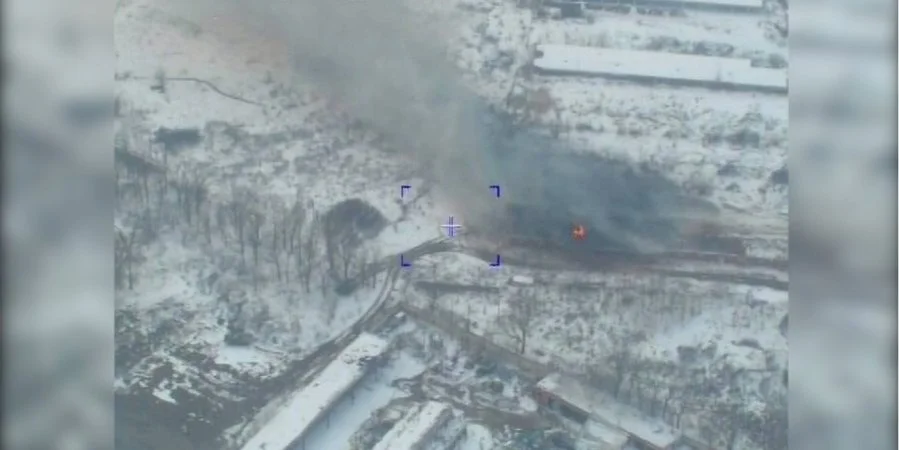Russia announced that it had attacked an underground warehouse of missiles and aviation ammunition in the Delyatyn, Ivano-Frankivsk region, with Kinzhal hypersonic missiles. The Armed Forces of Ukraine confirmed the hit but does not know if it was by Kinzhal missile.
“On March 18, the Kinzhal aviation missile system with hypersonic aeroballistic missiles destroyed a large underground warehouse of missiles and aviation ammunition of Ukrainian troops in the village of Delyatyn, Ivano-Frankivsk region,” said Major General Igor Konashenkov, spokesman for the Russian Defense Ministry.
According to Russian media, Kinzhal is an aviation complex with a high-precision hypersonic aeroballistic missile. The missile is launched from the modernized long-range fighter-interceptor MiG-31, the MiG-31K.
According to the Russian military, it can hit targets at a range of more than 2,000 km while being guaranteed to overcome all existing and developed air and missile defense systems.
Ten fighter-interceptors in the MiG-31K “Dagger” modification are on experimental combat duty in the Southern Military District of the Russian Federation.
The military also used Bastion coastal missile systems to destroy the electronic intelligence centres of the Ukrainian troops in the Odesa region.
“The Bastion coastal missile system destroyed the centres of radio and electronic intelligence of the Ukrainian armed forces in the settlements of Veliky Dalnik and Velikodolinskoye in the Odesa region,” he said.
What Ukraine says
Yuriy Ignat, the spokesman of the Ukrainian Air Force, said, “Indeed, the enemy struck at our storage depots, which have already been indicated. The type of missile will still be established. We have damage; we have destruction. There was a detonation of ammunition. The victims are being identified.”
“Ukraine, unfortunately, has become a testing ground for testing the entire arsenal of Russian missile weapons. They use missiles flying two thousand kilometres, five and a half thousand kilometres in range – these are cruise missiles, and Iskander operational-tactical systems, Cruise missiles “Kaliber” and others Kh-101, Kh-55, Kh-555.
“There was a statement about the “Dagger”, which the Russians brag about. We don’t know what the rocket actually was. We can’t confirm yet,” he added.
The Delyatyn Arms Depot – built for Soviet nuclear warheads
Ukraine decided to store ammunition at the Delyatyn Arms Depot in 2004. The warehouses have existed for a long time.
In the 1950s, the Ukrainian insurgents fell silent, and Prykarpattia (Ukrainian term for Ciscarpathia, a physical geographical region for the northeastern Carpathian foothills) fell into the inner zone of the Soviet Union’s defenses. In the forests of the Ivano-Frankivsk (until 1962 – Stanislavskaya) region, USSR began to build a complex of mysterious objects for the powerful nuclear missile system.

In the 1980s, planes with Generals from Moscow landed at a military airfield in Ivano-Frankivsk. In a matter of minutes, they were taken to a secret command post to begin military exercises, and then the whole system began to unravel. The SS-24 strategic missile launchers located in the Black Forest near the village of Grabivka in the Kalush district were tested for readiness. Nuclear warheads for intercontinental ballistic missiles were stored near the town of Delyatyn in the Nadvirna district – in a specially built hiding place inside the mountain.
The nuclear shield in the Black Forest was a protection for a secret command post of the Warsaw Pact troops stationed in an underground forest bunker near the inconspicuous village of Tsenzhiv, 10-12 kilometres from Ivano-Frankivsk. Until recently, Ukraine stored Mélange (a mixture of nitrates and organic matter and a liquid oxidant rocket fuel) at a missile depot near the village of Tsenzhiv.
After the collapse of the Soviet Union and Ukraine’s renunciation of nuclear weapons, the facility became unnecessary at one point. On the night of June 2, 1996, Ukraine became a state without nuclear weapons – the last missile was exported from its territory to Russia.
In 2014, a new application for underground storage was found, turning giant tunnels in the mountain’s depths into warehouses for conventional ammunition.
